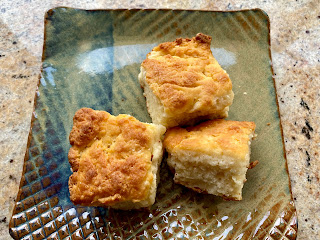In this close-up of the cut surface, you could appreciated fluffy texture.
As usual, I will ask my wife to take over.
Ingredients
8 tablespoons (1 stick/113 grams) unsalted butter
2 3/4 cups (345 grams) all-purpose flour
4 teaspoons baking powder
1 tablespoon granulated sugar (or more for a sweeter biscuit. I added two Tsp.)
2 teaspoons salt
2 cups (480 milliliters) well-shaken whole buttermilk
Directions
Position a rack in the middle of the oven and preheat to 450 degrees. Add the butter to a 9-inch square baking dish or cast iron frying pan and place in the oven while it preheats. (We did not have a 9-inch square baking dish so we used a 10 inch cast iron frying pan instead.) (If the oven is very slow to heat up, wait a few minutes to put in the baking dish so the butter doesn’t burn. Just keep an eye on it as it melts.)
In a large bowl, whisk together the flour, baking powder, sugar and salt until combined. Add the buttermilk and stir gently with a spatula just until combined. Do not overmix.
Remove the hot baking dish from the oven and gently pour the batter over the melted butter. Use a knife or offset spatula to spread the batter evenly in the dish (see picture below).
Quickly and confidently, use a knife to “cut” the dough into 9 squares. If the lines close up, go back and take another pass through, though you shouldn’t expect them to remain completely distinct. It can help to wipe or rinse off the knife in between cuts.
Bake for 20 to 25 minutes, rotating the pan halfway through, or until the tops of the biscuits are golden brown and the edges crisp. Following your scored lines, cut and serve.
As can be seen in the pictures above this bread is truly swimming in butter. It would be helpful if there was some way to turn it over half way through cooking because the bottom became almost too high done while the top was not yet brown. Although it is made with a few simple ingredients the flavor is fairly complex. The sweetness of the sugar combines with the taste of the butter, some of which gets browned and there is the pervasive undertone of the sharp taste of the buttermilk. In my humble opinion, both are good but “swimming in butter” is better. My wife said this one is easier to make


















